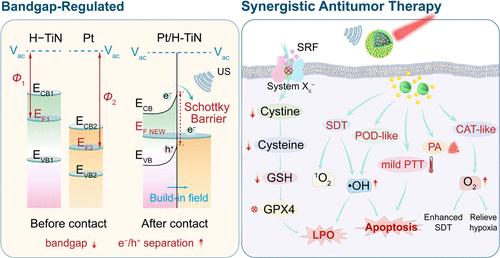Four Birds with One Stone: A Bandgap-Regulated Multifunctional Schottky Heterojunction for Robust Synergistic Antitumor Therapy upon Endo-/Exogenous Stimuli
IF 16
1区 材料科学
Q1 CHEMISTRY, MULTIDISCIPLINARY
引用次数: 0
Abstract
Considering the profound impact of structure on heterojunction catalysts, the rational design of emerging catalysts with optimized energy band structures is required for antitumor efficiency. Herein, we select titanium nitride (TiN) and Pt to develop a multifunctional Schottky heterojunction named Pt/H-TiN&SRF (PHTS) nanoparticles (NPs) with a narrowed bandgap to accomplish “four birds with one stone” involving enzyo/sono/photo three modals and additional ferroptosis. The in situ-grown Pt NPs acted as electron traps that can cause the energy band to bend upward and form a Schottky barrier, thereby facilitating the separation of electron/hole pairs in exogenous stimulation catalytic therapy. In addition, endogenous catalytic reactions based on peroxidase (POD)- and catalase (CAT)-mimicking activities can also be amplified, triggering intense oxidative stress, in which CAT-like activity decomposes endogenous H2O2 into O2 alleviating hypoxia and provides reactants for sonodynamic therapy. Moreover, PHTS NPs can elicit mild photothermal therapy with boosted photothermal properties as well as ferroptosis with loaded ferroptosis inducer sorafenib for effective tumor ablation and apoptosis–ferroptosis synergistic tumor inhibitory effect. In summary, this paper proposes an attractive design for antitumor strategies and highlights findings for heterojunction catalytic therapy with potential in tumor theranostics.

一石四鸟:带隙调节型多功能肖特基异质结:在内源性/外源性刺激下实现稳健的协同抗肿瘤疗法
考虑到结构对异质结催化剂的深远影响,需要合理设计具有优化能带结构的新兴催化剂,以提高抗肿瘤效率。在此,我们选择氮化钛(TiN)和铂(Pt)来开发一种多功能肖特基异质结,命名为Pt/H-TiN&SRF(PHTS)纳米粒子(NPs),其带隙变窄,可实现 "一石四鸟",包括酶/声/光三模和附加铁跃迁。原位生长的铂 NPs 可作为电子陷阱,使能带向上弯曲并形成肖特基势垒,从而促进外源刺激催化疗法中电子/空穴对的分离。此外,基于过氧化物酶(POD)和过氧化氢酶(CAT)模拟活性的内源性催化反应也可被放大,从而引发强烈的氧化应激,其中 CAT 类活性可将内源性 H2O2 分解为 O2,缓解缺氧,并为声动力疗法提供反应物。此外,PHTS NPs 还能诱导温和的光热疗法,增强光热特性,并通过负载的铁凋亡诱导剂索拉非尼诱导铁凋亡,有效消融肿瘤,发挥凋亡-铁凋亡协同抑瘤效应。总之,本文提出了一种极具吸引力的抗肿瘤策略设计,并重点介绍了具有肿瘤治疗学潜力的异质结催化疗法的研究成果。
本文章由计算机程序翻译,如有差异,请以英文原文为准。
求助全文
约1分钟内获得全文
求助全文
来源期刊

ACS Nano
工程技术-材料科学:综合
CiteScore
26.00
自引率
4.10%
发文量
1627
审稿时长
1.7 months
期刊介绍:
ACS Nano, published monthly, serves as an international forum for comprehensive articles on nanoscience and nanotechnology research at the intersections of chemistry, biology, materials science, physics, and engineering. The journal fosters communication among scientists in these communities, facilitating collaboration, new research opportunities, and advancements through discoveries. ACS Nano covers synthesis, assembly, characterization, theory, and simulation of nanostructures, nanobiotechnology, nanofabrication, methods and tools for nanoscience and nanotechnology, and self- and directed-assembly. Alongside original research articles, it offers thorough reviews, perspectives on cutting-edge research, and discussions envisioning the future of nanoscience and nanotechnology.
 求助内容:
求助内容: 应助结果提醒方式:
应助结果提醒方式:


